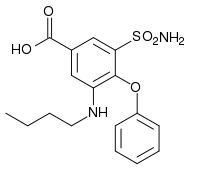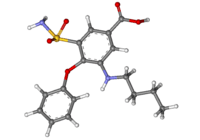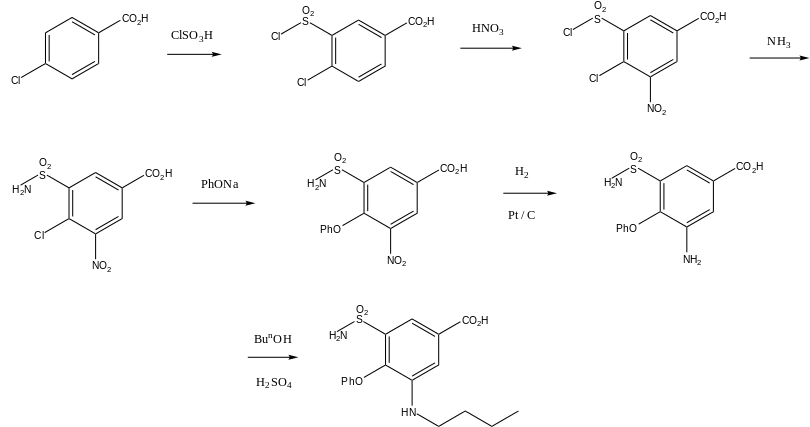Bumetanide
 | |
 | |
| Clinical data | |
|---|---|
| Trade names | Bumex |
| AHFS/Drugs.com | Monograph |
| MedlinePlus | a684051 |
| Pregnancy category | |
| Routes of administration | oral, intravenous, intramuscular |
| ATC code | |
| Legal status | |
| Legal status | |
| Pharmacokinetic data | |
| Bioavailability | almost complete (~80%) |
| Protein binding | 97% |
| Metabolism | hepatic |
| Elimination half-life | ~0.8 hours |
| Excretion | renal |
| Identifiers | |
| |
| CAS Number | |
| PubChem CID | |
| IUPHAR/BPS | |
| DrugBank | |
| ChemSpider | |
| UNII | |
| KEGG | |
| ChEBI | |
| ChEMBL | |
| ECHA InfoCard |
100.044.534 |
| Chemical and physical data | |
| Formula | C17H20N2O5S |
| Molar mass | 364.417 g/mol |
| 3D model (JSmol) | |
| |
| |
| (verify) | |
Bumetanide (trade names Bumex or Burinex) is a loop diuretic of the sulfamyl category, most often used to treat heart failure. It is often used in people in whom high doses of furosemide or other diuretics are ineffective. It is marketed by Hoffmann-La Roche. The main difference between bumetanide and furosemide is in their bioavailability and potency. About 60% of furosemide is absorbed in the intestine, and there are substantial inter- and intraindividual differences in bioavailability (range 10-90%). About 80% of bumetanide is absorbed, and its absorption does not change when it is taken with food. It is said to be a more predictable diuretic, meaning that the predictable absorption is reflected in a more predictable effect.[1]
Bumetanide is 40 times more potent than furosemide for patients with normal renal function.[1]
In the brain, bumetanide blocks the NKCC1 cation-chloride co-transporter, and thus decreases internal chloride concentration in neurons. In turn, this concentration change makes the action of GABA more hyperpolarizing, which may be useful for treatment of neonatal seizures, which quite often are not responsive to traditional GABA-targeted treatment, such as barbiturates. Bumetanide is therefore currently under evaluation as a prospective antiepileptic drug.[2]
Abuse
On October 24, 2008, ESPN reported that four NFL players were being suspended under the steroid policy as a result of taking bumetanide.[3] It is sometimes used for weight loss because, as a diuretic, it removes water, but it also masks other drugs, including steroids, by diluting the contents of the user's urine, yielding a lower concentration of filtered substances, which makes them less likely to be detected.
Bumetanide was an undisclosed active ingredient in the over-the-counter weight loss supplement StarCaps, which was removed from the market after its presence was discovered by the United States Food and Drug Administration.[4]
Synthesis
Bumetanide, 3-butylamino-4-phenoxy-5-sulfamoylbenzoic acid, is synthesized from 4-chlorobenzoic acid. In the first stage of synthesis, it undergoes sulfonylchlorination by chlorosulfonic acid, forming 4-chloro-3-chlorosulfonylbenzoic acid, which is further nitrated with nitric acid to 4-chloro-3-chlorosulfonyl-5-nitrobenzoic acid. Reacting this with ammonia gives 5-aminosulfonyl-4-chloro-3-nitrobenzoic acid, which when reacted with sodium phenolate is transformed into 5-amino-sulfonyl-3-nitro-5-phenoxybenzoid acid. Reduction of the nitro group in this product by hydrogen using a palladium on carbon catalyst gives 3-amino-5-aminosulfonyl- 5-phenoxybenzoic acid. Finally, reacting this with butyl alcohol in the presence of sulfuric acid gives the desired bumetanide.
References
- 1 2 Brunton, Laurence; Lazo, John S.; Parker, Keith L., eds. (2006). Goodman & Gilman's The Pharmacological Basis of Therapeutics (11th ed.). New York: McGraw-Hill. pp. 749–753. ISBN 0-07-142280-3.
- ↑ Löscher W, Puskarjov M, Kaila K (June 2013). "Cation-chloride cotransporters NKCC1 and KCC2 as potential targets for novel antiepileptic and antiepileptogenic treatments". Neuropharmacology. 69: 62–74. doi:10.1016/j.neuropharm.2012.05.045. PMID 22705273.
- ↑ "McAllister, Smith, Grant, Texans' Pittman among players testing positive". ESPN.com. ESPN. October 26, 2008. Retrieved June 6, 2017.
- ↑ "Food and Drug Administration Office of Criminal Investigations – U.S. Department of Justice Press Release – Pills Sold Throughout the United States Contained an Undisclosed Prescription Drug Banned By the National Football League". fda.gov. United States Food and Drug Administration. March 26, 2014. Retrieved June 6, 2017.
- ↑ Loevens Kemiske Fabrik Produktionsaktieselskab (Jul 9, 1970). "Neue Sulfamylbenzoesaeurederivate". DPMAregister (in German). Ger. Pat. 19 64 503.5: German Patent and Trade Mark Office. Retrieved 20 June 2018.
- ↑ Loevens Kemiske Fabrik Produktionsaktieselskab (Jul 9, 1970). "Arzneimittelzubereitung mit einem Gehalt an 3-Butylamino-4-phenoxy-5-sulfamylbenzoesaeure und deren Salzen". DPMAregister (in German). Ger. Pat. 19 64 504.6: German Patent and Trade Mark Office. Retrieved 20 June 2018.
- ↑ Feit, P. W. (1971). "Aminobenzoic acid diuretics. 2. 4-Substituted-3-amino-5-sulfamoylbenzoic acid derivatives". Journal of Medicinal Chemistry. 14 (5): 432–9. doi:10.1021/jm00287a014. PMID 5117690.
- ↑ Feit, Peter Werner (11 January 1972). "Pharmaceutical composition for the treatment of oedematous conditions and hypertension" (PDF). US Pat. 3634583A: Leo Pharmaceutical Products Ltd AS. Retrieved 20 June 2018.
- ↑ Feit, Peter Werner; Nielsen, Ole Bent Tvaermose; Bruun, Herta; Bretting, Claus Aage Svensgaard (4 April 1978). "Sulphonamides, compositions containing the same and methods for using the same in the treatment of hypertension or odemeas" (PDF). US Pat. US4082851A: Leo Pharmaceutical Products Ltd AS. Retrieved 20 June 2018.
External links
- Bumex package insert (FDA)
